Centauri Dreams
Imagining and Planning Interstellar Exploration
New Horizons Parallax Program Gears Up
Back in January — and boy does that seem like another era — I wrote about the plan to look at two nearby stars with the help of the New Horizons spacecraft as well as observations from the general public. If you’d like to get involved, there is still time, but the date is fast approaching. Amateur equipment and digital cameras have reached the point where astronomy at a very high level can be conducted from small observatories and even back yards. Here’s another chance to make the case for the value of such work.
Tha planned observations take advantage of parallax, the apparent shift in position of nearby stars as measured using the radius of the Earth’s orbit. Friedrich Bessel’s groundbreaking work on stellar distances involved taking such measurements to calculate the distance of 61 Cygni, all this back in 1838. The apparent shift of the star against background stars allowed him to peg 61 Cygni’s distance at 10 light years, reasonably close to the modern figure of 11.4.
New Horizons gives us a baseline extending all the way to the Kuiper Belt. By the time we take the upcoming observations of Proxima Centauri and Wolf 359, the spacecraft will be 46 times farther from the Sun than Earth (some 8 billion kilometers out). Combining the New Horizons data with Earth-based images made on April 22 and 23 will yield a record-setting parallax measurement as the two stars seem to shift in position against the background.
“These exciting 3D images, which we’ll release in May, will be as if you had eyes as wide as the solar system and could detect the distance of these stars yourself,” said New Horizons Principal Investigator Alan Stern, of the Southwest Research Institute, Boulder, Colorado. “It’ll be a truly vivid demonstration of the immense distance New Horizons has traveled, and a cool way to take advantage of the spacecraft’s unique vantage point out on the very frontier of our solar system!”
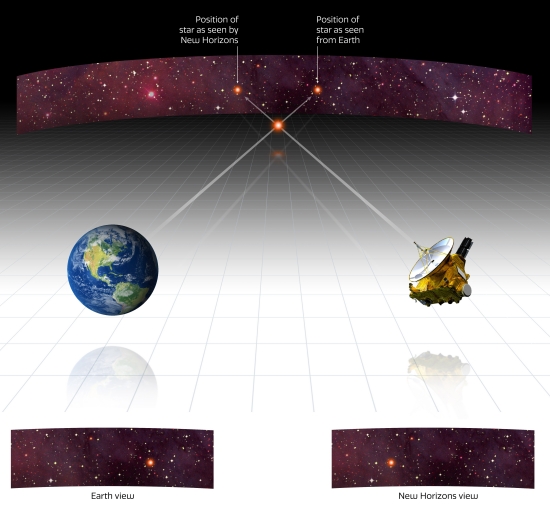
Image: This figure illustrates the phenomenon of stellar parallax. When New Horizons and observers on Earth observe a nearby star at the same time, it appears to be in different places compared to more distant background stars — this is because New Horizons has traveled so far out in space that it has to look in a different direction to see that star. The small images below Earth and New Horizons show each unique view. Note that the farther-away background stars stay in the same place, but the nearby star appears to move between the two vantage points. Credit: Pete Marenfeld, NSF’s National Optical-Infrared Astronomy Research Laboratory.
Those wishing to participate will need a camera equipped telescope with 6-inch aperture or larger. To learn more, click here. Proxima Centauri is 4.244 light years away, a distant companion to the primary Centauri A and B stars. It’s also at quite a large angle in the sky from Wolf 359, making both stars a useful reference as the team explores autonomous interstellar navigation. Robotic missions within the Solar System have used optical imagery for navigation before, but New Horizons takes the technique into interstellar trajectories as it heads out ever deeper into the Kuiper Belt. Thus New Horizons science team member Tod Lauer:
“For all of history, the fixed stars in the night sky have served as navigation markers. As we voyage out of the solar system and into interstellar space, how the nearer stars shift can serve as a new way to navigate. We will see this for the first time with New Horizons.”
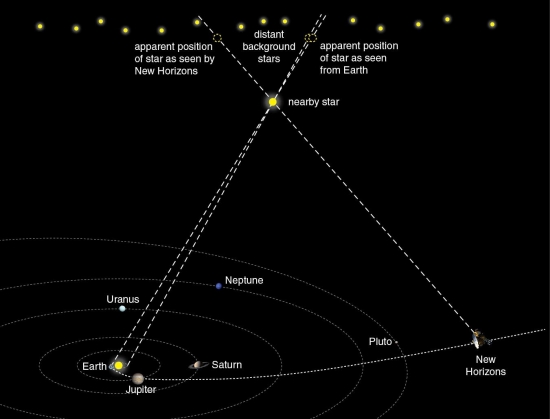
Image: This figure, by New Horizons contributing scientist Brian May, shows the parallax as an effect of New Horizons’ travels deeper into the Kuiper Belt. Traditionally, parallax is measured as the Earth orbits around the sun. The two lines at left show the lines of sight from Earth to the star on either side of Earth’s orbit. This causes a small shift in the position of the nearby star compared to more distant stars. New Horizons is so far away that a much larger shift in the line of sight to the star occurs. Credit: Brian May.
As for Wolf 359, it’s a red dwarf 7.9 light years away in Leo. You may recall numerous science fiction references to the star, ranging from “Wolf 359”, an episode on the 60’s TV show The Outer Limits to Harry Harrison’s Captive Universe (1969), a generation ship novel, and a double episode of Star Trek: The Next Generation. More recently, there is the Hugo nominated Ken MacLeod short story “Who’s Afraid of Wolf 359?”
While Proxima Centauri is not visible for most northern hemisphere observers, Wolf 359 should be observable from both hemispheres with telescopes of sufficient aperture. Star charts of the Wolf 359 and Proxima Centauri fields are available at the project site.

Kepler-1649c: Interesting Earth-sized Planet Turns Up in Kepler Data
What intrigues me about Kepler-1649c, a newly discovered planet thrust suddenly into the news, isn’t the fact that it’s potentially in its star’s habitable zone, nor that it is close to being Earth-sized (1.06 times Earth’s radius). Instead, I’m interested in the way it was found. For this is a world turned up in exhaustive analysis of data from the original Kepler mission. Bear in mind that data from the original Kepler field ceased being gathered a full seven years ago.
I share Jeff Coughlin’s enthusiasm on the matter. Coughlin is an astronomer affiliated with the SETI Institute who is a co-author on the new paper, which appears in Astrophysical Journal Letters. One of the goals of the mission that began as Kepler and continued (on different star fields) as K2 was to find the fraction of stars in the galaxy that have planets in the habitable zone, using transit methods for initial detection and radial velocity follow-up on Earth. Of the new find, made with an international team of scientists, Coughlin says:
“It’s incredible to me that we just found [Kepler-1649c] now, seven years after data collection stopped on the original Kepler field. I can’t wait to see what else might be found in the rich dataset from Kepler over the next seven years, or even seventy.”
Yes, because we’re hardly through with a dataset that has taken in close to 200,000 stars. What the new planet reminds us is that the initial detection stage of Kepler’s work long ago ceded to analysis of how many of the acquired signals are due to systematic effects in the instrumentation, or variable stars, or perhaps binaries, for so many things can appear to be the signature of a planet when they are not. Making computer algorithms to automate this work has occurred only after intensive human study to learn the best ways to distinguish between signals.
But consider: The algorithm, called Robovetter, that was used to distinguish false positives was working on data in which only 12 percent of the transit signals turned out to be planets. We have false positives galore, out of which we now get the Kepler False Positive Working Group to serve as a double-check on the algorithm’s work. The KFPWG is a dedicated team indeed, taking years to review the thousands of signals from the original Kepler dataset. Kepler-1649c comes out of this review, a world that had been misclassified by the automated methods earlier on. Clearly, humans and machines learn from each other as they make such difficult calls.
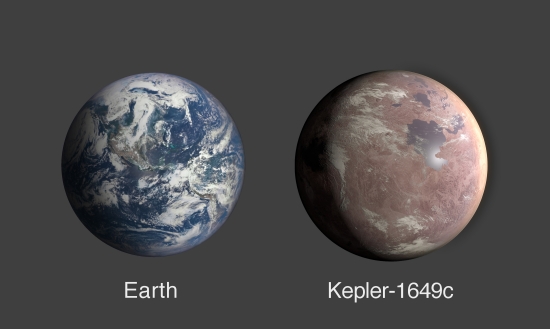
Image: A comparison of Earth and Kepler-1649c, an exoplanet only 1.06 times Earth’s radius. Credit: NASA/Ames Research Center/Daniel Rutter.
I yield to the experts when it comes to habitability, and trust our friend Andrew LePage will weigh in soon with his own analysis. What we do know is that this planet receives about 75 percent of the amount of light Earth receives from the Sun, though in this case the star in question is a red dwarf of spectral type M5V, the same as Proxima Centauri, fully 300 light years out. As always with red dwarfs, we bear in mind that stellar flares are not uncommon. The planet orbits its star every 19.5 days. We have no information about its atmosphere.
Even so, lead author Andrew Vanderburg (University of Texas at Austin) notes the potential for habitability:
“The more data we get, the more signs we see pointing to the notion that potentially habitable and Earth-sized exoplanets are common around these kinds of stars. With red dwarf stars almost everywhere around our galaxy, and these small, potentially habitable and rocky planets around them too, the chance one of them isn’t too different than our Earth looks a bit brighter.”
There is a planet on an orbit interior to Kepler-1649c, a super-Earth standing in relation to the former much as Venus does to the Earth. The two demonstrate an uncommon nine-to-four orbital resonance, one that hints at the possibility of a third planet between them. This would give us a pair of three-to-two resonances, a much more common scenario, though no trace of the putative world shows up in the data. If there, it is likely not a transiting planet.
I rather like the image that comes out of NASA Ames, where the Kepler effort is managed, but I like it as a kind of science fictional art, the sort of thing to be found on SF paperbacks. It’s evocative and suggestive, but of course we have no idea what this world really looks like.
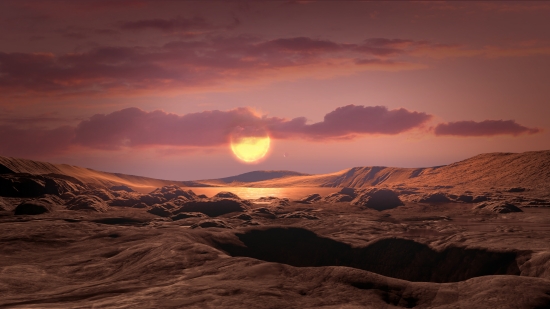
Image: An illustration of what Kepler-1649c could look like from its surface. Credit: NASA/Ames Research Center/Daniel Rutter.
The paper is Vanderburg et al., “A Habitable-zone Earth-sized Planet Rescued from False Positive Status,” Astrophysical Journal Letters Vol. 893, No. 1 (1 April 2020). Abstract.

PUNCH: Imaging the Solar Wind
Get ready for the Polarimeter to UNify the Corona and Heliosphere (PUNCH) mission, which will begin popping up even as Centauri Dreams continues to consider heliophysics in relation to proposed missions far beyond the Solar System. We’ve seen recently that the Applied Physics Laboratory at Johns Hopkins is looking, under the leadership of Ralph McNutt, at a mission to 1000 AU, using an Oberth maneuver at the Sun as a possible way to reach such distances with a flight time of 50 years (see The 1000 AU Target). Thus do heliophysics and deep space intersect in unexpected ways, and not just at APL but JPL and elsewhere as we look toward the upcoming decadal survey.
As for PUNCH, it’s all about the solar wind and the connection between it and the Sun’s corona, says PUNCH principal investigator Craig DeForest of Southwest Research Institute’s Space Science and Engineering Division:
“For over 50 years, we’ve studied the solar corona by remote imaging and the solar wind by direct sampling. PUNCH will bridge that gap by imaging the solar wind itself as it leaves the outermost reaches of the Sun’s corona.”
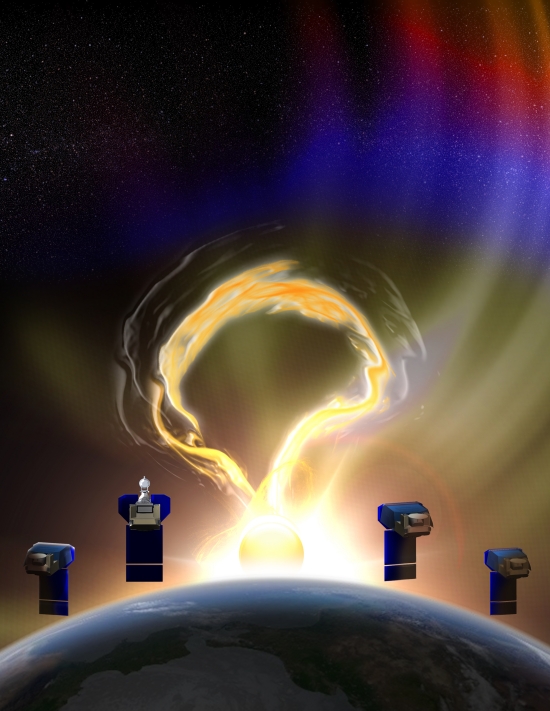
Image: NASA has selected Southwest Research Institute to lead a microsatellite mission to image the Sun’s outer corona. PUNCH proposes a constellation of four suitcase-sized satellites that will orbit the Earth, studying how the Sun’s corona connects with the interplanetary medium, to better understand how coronal structures infuse the solar wind with mass and energy. Credit: Southwest Research Institute.
The four PUNCH spacecraft will orbit the Earth as a constellation in a polar orbit. Aboard one will be a coronagraph whose Narrow Field Imager will watch the Sun’s corona continuously, while wide-angle cameras and Wide Field Imagers optimized to image the solar wind with a 90 degree field of view are aboard the other three. The good news about PUNCH is that it has now passed the System Requirements Review/Mission Definition Review, a major step for this NASA Small Explorer (SMEX) mission.
The spacecraft will be built, along with the Wide Field Imagers, by the Southwest Research Institute (SwRI), while the US Naval Research Laboratory will produce the Narrow Field Imager, with additional contributions from the Rutherford Appleton Laboratory in Oxfordshire, England. The work has continued despite the extraordinary conditions forced by COVID-19. Says principal investigator Craig DeForest (SwRI):
“Preparing for the SRR/MDR review was an unexpected challenge. Team members have been working at home for over three weeks, yet they met the challenge and presented their design in written and oral presentations culminating in the positive decision from our review board. I’m very proud of this team for what they’ve accomplished during less than ideal collaboration conditions. While spacecraft are constructed out of aluminum and exotic metals, they are initially made of requirements documents.”
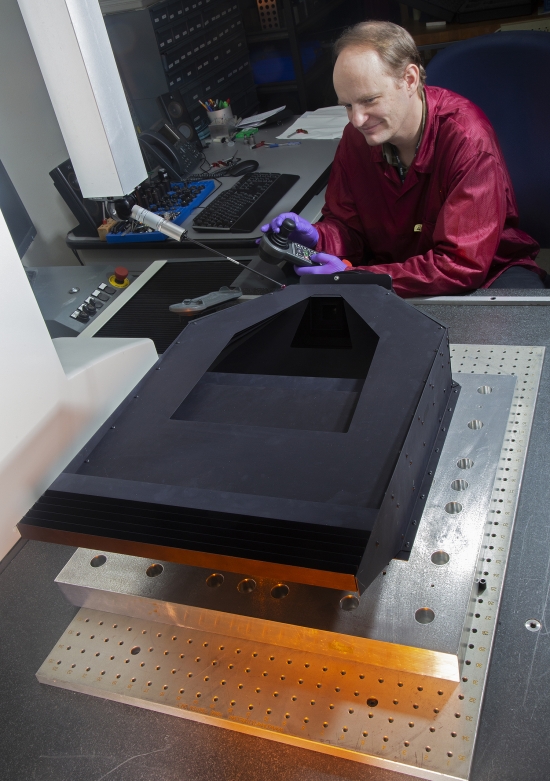
Image: SwRI developed and prototyped the Wide Field Imager for the PUNCH mission. The dark baffles in the top recess allow the instrument to image objects over a thousand times fainter than the Milky Way. Credit: Southwest Research Institute.
A major document requirement has now been passed. Insights into the solar wind are sure to flow from this mission. And from a deep space perspective, a number of concepts have been advanced that would ‘ride’ the solar wind despite its turbulence. More accurate modeling in such studies will surely be an ancillary result from PUNCH, as will improved understanding of conditions near the Sun for future spacecraft on close flybys.

A Formation Scenario for ‘Oumuamua
The interstellar object we call ‘Oumuamua was bound to be fascinating no matter what it actually was. You discover the first incoming object from interstellar space only once. But this one had its own share of peculiarities. Here was what was assumed to be a comet, but one that showed no outgassing as it reached perihelion and in fact seemed to be unusually dry. Here was an object of an apparently elongated shape, an aspect ratio with which we had nothing to compare in our own system. A tiny but detectable acceleration on the way out of the system seemed to indicate later outgassing, but how was that consistent with earlier data?
I think Harvard’s Avi Loeb was exactly right to point out that among the possible explanations of new objects, we can’t disregard the possibility of a technology from another civilization. That ‘Oumuamua was a natural object is an obvious default position, but we are at a stage in our understanding of the cosmos when we realize that the conditions for life occur elsewhere. We don’t know how often it forms — abiogenesis may be spectacularly rare. But maybe not.
But while we’ll never know with 100 percent certainty what ‘Oumuamua was, we can look forward to many more interstellar objects to evaluate as new instrumentation comes online. Meanwhile, that apparently elongated shape that so distinguished ‘Oumuamua has come under scrutiny from Yun Zhang (National Astronomical Observatories of the Chinese Academy of Sciences) and Douglas N. C. Lin (UC-Santa Cruz), who have run computer simulations that show how it could have formed and go on to explain its other oddball quirks.
“We showed that ‘Oumuamua-like interstellar objects can be produced through extensive tidal fragmentation during close encounters of their parent bodies with their host stars, and then ejected into interstellar space,” says Lin. “Our objective is to come up with a comprehensive scenario, based on well understood physical principles, to piece together all the tantalizing clues.”
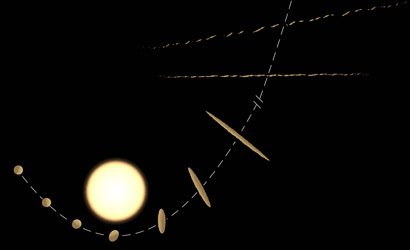
Image: This illustration shows the tidal disruption process that can give rise to ‘Oumuamua-like objects. Credit: NAOC/Y. Zhang.
Tidal forces are the key to this work, which is described in a paper in Nature Astronomy. Think Shoemaker-Levy 9, whose spectacular disintegration produced the famous ‘chain of pearls’ as the comet was progressively torn apart by Jupiter’s gravity. In Zhang and Lin’s simulations, the modeling of the structural dynamics of an object passing close to its star produces extremely elongated fragments that are then ejected into deep space. The work shows that aspect ratios even greater than 10 to 1 are not out of the question.
Could such a shape be stable? Evidently so, for the scientists used thermal modeling to show that at tight stellar distances, the surface of such an object would melt and then recondense on its way out of the system, producing a crust that should remain cohesive. We get a ‘shard’ of material being flung into the cosmos in a random direction. Moreover, this is a process that contains within it other unusual aspects of the ‘Oumuamua encounter with our system.
“Heat diffusion during the stellar tidal disruption process also consumes large amounts of volatiles, which not only explains ‘Oumuamua’s surface colors and the absence of visible coma, but also elucidates the inferred dryness of the interstellar population,” Zhang said. “Nevertheless, some high-sublimation-temperature volatiles buried under the surface, like water ice, can remain in a condensed form.”
So we circle back to the fact that ‘Oumuamua showed no cometary activity but an apparent outgassing sufficient to produce a non-gravitational motion, albeit a tiny one. Under the modeling Zhang and Lin performed, the warmth of the approach to perihelion would have activated residual water stores that match the observed trajectory of ‘Oumuamua.
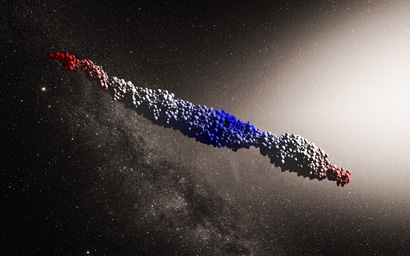
Image: A ‘Oumuamua-like object produced by a simulation of the tidal disruption scenario proposed by Zhang and Lin. Credit: NAOC/Y. Zhang; background: ESO/M. Kornmesser.
We should expect quite a few more interstellar objects in our future. Zhang and Lin believe that on average, a single planetary system should eject a total of about a hundred trillion objects like ‘Oumuamua. The tidal forces in play in these simulations work for any number of source objects, from super-Earths to long-period comets and other material from a debris disk. In other words, there is hardly a shortage of material out of which to form interstellar objects. Doubtless our Sun has spewed its share into nearby interstellar space, shard-like or not.
We’ve had a second interstellar object since ‘Oumuamua, the much more comet-like 2I/Borisov. Whether Zhang and Lin are right in their assessment may eventually become clear as we detect and study further examples. Given their apparent plenitude, we should by virtue of these simulations assume that some, if not many, will share some of the traits of ‘Oumuamua. Eventually we’ll build a catalog that may teach us something about planetary evolution.
The paper is Zhang and Lin, “Tidal fragmentation as the origin of 1I/2017 U1 (‘Oumuamua),” Nature Astronomy 13 April 2020 (abstract).

Measuring a Brown Dwarf’s Winds
The brown dwarf 2MASS J10475385+2124234 is about the size of Jupiter, but maybe 40 times more massive. 33.2 light years from Earth, this object is in that category between planet and star, not massive enough to launch the same kind of nuclear reactions that power the Sun, but considerably more massive than any planet. Combining two tools — the Very Large Array (VLA) and NASA’s Spitzer Space Telescope — scientists have now measured the wind speed here.
Katelyn Allers (Bucknell University), who led the research team, realized that the combination of radio observations (VLA) and infrared (Spitzer) would make this kind of measurement possible, and expressed surprise that no one else had thought to do it before. After all, we already knew that the rotation period of Jupiter found through radio measurements differs from the period found at visible and infrared wavelengths. That disparity is key to the new measurement.
For the difference is the result of two separate phenomena. Radio emissions from Jupiter are caused by electrons interacting with the planet’s huge magnetic field, located deep in the interior. The infrared emission is measured at the top of the atmosphere. Because the atmosphere is rotating more quickly than the interior, we have a difference in velocity due to atmospheric winds. The same kind of measurement is now put to use at a brown dwarf.
“Since the magnetic field originates deep in the planet, or in this case brown dwarf, the radio data allows us to determine the interior period of rotation,” Allers says. “When you have an interior rotation rate and an atmospheric rotation rate, you can compare them to see how fast the wind is blowing.”
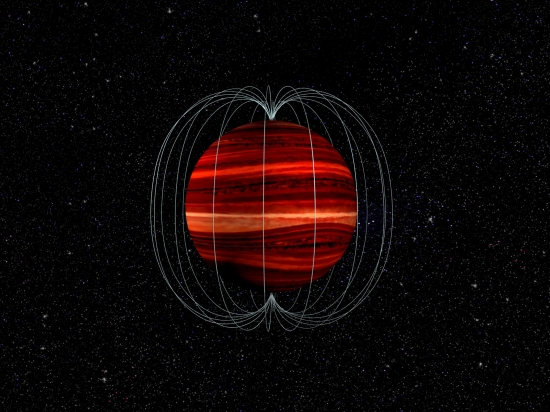
Image: Artist’s conception of a brown dwarf and its magnetic field. The magnetic field, rooted deep in its interior, rotates at a different rate than the top of the atmosphere. The difference allowed astronomers to determine the object’s wind speed. Credit: Bill Saxton, NRAO/AUI/NSF.
Allers and company observed 2MASS J10475385+2124234 with Spitzer in 2017 and 2018, noting the interesting fact that its infrared brightness varies regularly, indicating a long-lived feature of some sort in the upper atmosphere. Does this brown dwarf have something analogous to Jupiter’s Great Red Spot? That we can’t know at this point, but a set of VLA observations from 2018 measured the rotation period of the brown dwarf’s interior, so we do know about the winds.
The Jupiter analogy holds, for the brown dwarf’s atmosphere does indeed rotate faster than its interior, allowing the calculation of a wind speed of about 2300 kilometers per hour. By comparison, Jupiter’s wind speed clocks in at around 370 kilometers per hour. According to Allers, the difference is in agreement with theory and simulations of brown dwarf wind speeds.
This initial measurement may alert us to a technique that can measure winds not only on other brown dwarfs but on some giant exoplanets, although as co-author Peter K.G. Williams notes, the magnetic fields of such worlds are weaker than those of brown dwarfs, so the radio measurements would be conducted at lower frequencies than those used in the 2MASS J10475385+2124234 work. Williams (Center for Astrophysics | Harvard & Smithsonian) led the radio astronomical observations at the VLA.
“For the first time ever, we measured the speed of the winds of a brown dwarf — too big to be a planet, too small to be a star,” Williams adds. “The results rule out a few unusual models and prove that this new technique works and can be applied to more objects… This new technique opens the way to better understanding the behavior of atmospheres that are unlike anything found in our solar system.”
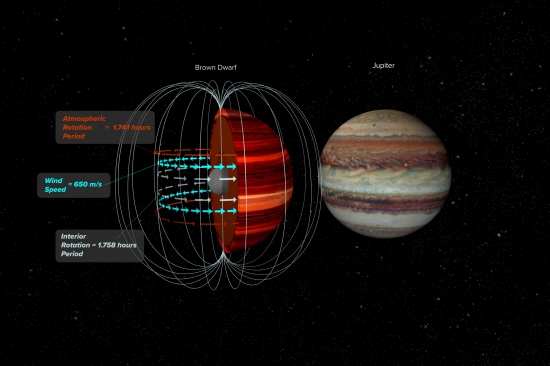
Image: Brown dwarf, left, and Jupiter, right. Artist’s conception of brown dwarf illustrates magnetic field and atmosphere’s top, which were observed at different wavelengths to determine wind speeds. Credit: Bill Saxton, NRAO/AUI/NSF.
The paper is Allers et al., “A Measurement of the Wind Speed on a Brown Dwarf,” Science Vol. 368, Issue 6487 (10 April 2020). Abstract.

Cassini: How Saturn Heats Its Upper Atmosphere
Given their distance from the Sun, the gas and ice giants of our Solar System should not have upper atmospheres as hot as they are. Clearly, something is happening at the planets themselves to account for the warmth, and new analysis of Cassini data, just published in Nature Astronomy, lays out the case for auroral activity at the north and south poles of Saturn as the explanation there. The paper offers the results of the most complete mapping yet made of the temperature and density of a gas giant planet’s upper atmosphere.
Tommi Koskinen, a co-author on the paper describing these findings is a member of Cassini’s Ultraviolet Imaging Spectrograph (UVIS) team:
“The results are vital to our general understanding of planetary upper atmospheres and are an important part of Cassini’s legacy. They help address the question of why the uppermost part of the atmosphere is so hot while the rest of the atmosphere – due to the large distance from the Sun – is cold.”
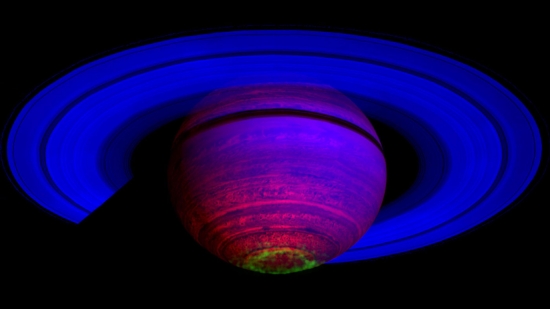
Image: This false-color composite image, constructed from data obtained by NASA’s Cassini spacecraft, shows the glow of auroras streaking out about 1,000 kilometers (600 miles) from the cloud tops of Saturn’s south polar region. It is among the first images released from a study that identifies images showing auroral emissions out of the entire catalogue of images taken by Cassini’s visual and infrared mapping spectrometer. Credit: NASA/JPL/ASI/University of Arizona/University of Leicester.
The process at Saturn is much the same as what drives Earth’s auroral activity. Plasma from the solar wind moves along magnetic field lines in the upper atmosphere, where electrons collide with atmospheric atoms and molecules, exciting them to higher energy levels that radiate light at various colors and wavelengths. The differences in atmospheric composition mean that at Saturn, the light we see comes from emissions of molecular and atomic hydrogen.
Like Voyager, the trove of Cassini data keeps churning up new insights. In this case, we’re dealing with data collected during the spacecraft’s Grand Finale, the 22 breathtakingly tight orbits made before the craft was flown into Saturn’s atmosphere to protect potentially life-bearing moons like Enceladus. Cassini had already orbited Saturn for more than 13 years and was at the end of its fuel supply, but those final orbits were exceedingly productive.
Targeting bright stars in the constellations of Orion and Canis Major, Cassini spent six weeks observing the stars rising and setting behind the planet, allowing scientists to measure the changes in starlight passing through the atmosphere. The temperature map used in the new paper relies on density measurements that provided the information needed to calculate atmospheric temperatures. Temperatures were found to peak near the auroras, giving credence to the idea that auroral electric currents are the heat source for the upper atmosphere.
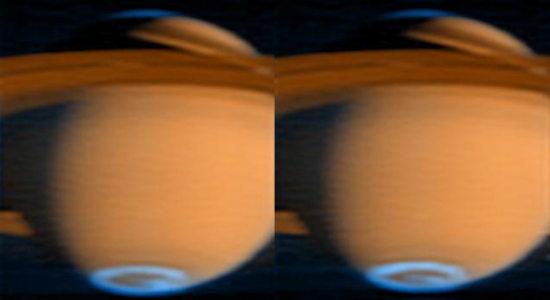
Image; The aurora at Saturn’s southern pole is visible in these false-color images, gathered by Cassini’s ultraviolet imaging spectrograph (UVIS) on June 21, 2005. Blue represents aurora emissions from hydrogen gas excited by electron bombardment, while red-orange represents reflected sunlight. The images show that the aurora lights at the polar regions respond rapidly to changes in the solar wind. Previous images have been taken closer to the equator, making it difficult to see the polar regions. Changes in the emissions inside the Saturn south-pole aurora are visible by comparing the two images, taken about one hour apart. The brightest spot in the left aurora fades, and a bright spot appears in the middle of the aurora in the second image. Credit: NASA/JPL/University of Colorado.
The rate of density decrease in the atmosphere depends on temperature, and the combination of temperature and density measurements helped the researchers determine the speed of the winds at altitude. Thus we get a glimpse of the zone where space weather interacts directly with a planet, showing how a global wind system distributes energy that is initially accumulated near the poles and then flows on into the equatorial regions. We wind up with the observed temperatures at altitude that are twice what we would expect from solar heating alone.
The paper is Brown et al., “A pole-to-pole pressure-temperature map of Saturn’s thermosphere from Cassini Grand Finale data,” Nature Astronomy 6 April 2020 (abstract).


